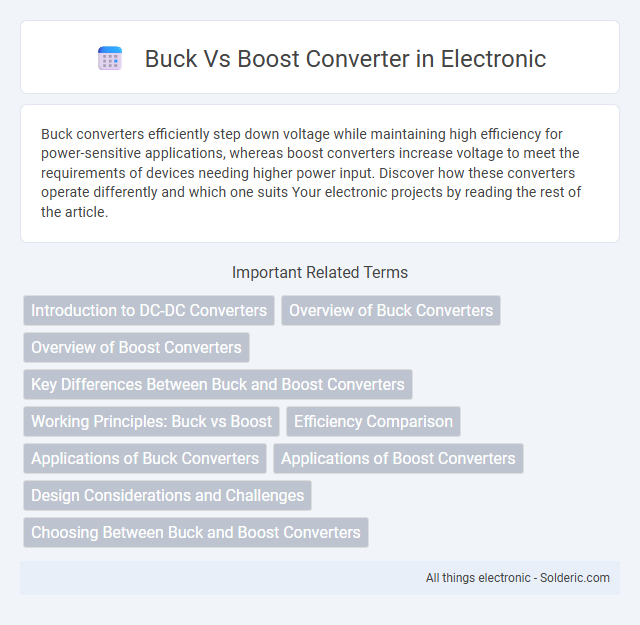Buck converters efficiently step down voltage while maintaining high efficiency for power-sensitive applications, whereas boost converters increase voltage to meet the requirements of devices needing higher power input. Discover how these converters operate differently and which one suits Your electronic projects by reading the rest of the article.
Comparison Table
| Feature | Buck Converter | Boost Converter |
|---|---|---|
| Function | Steps down voltage (Voltage Reduction) | Steps up voltage (Voltage Increase) |
| Output Voltage | Less than input voltage | Greater than input voltage |
| Typical Application | Power supplies, voltage regulation | Battery-powered devices, voltage boost |
| Efficiency | High efficiency (up to 95%) | High efficiency (up to 90-95%) |
| Complexity | Moderate | Moderate to high |
| Voltage Ripple | Lower voltage ripple | Higher voltage ripple |
| Inductor Usage | Inductor in series with input | Inductor in series with output |
| Continuous Conduction Mode (CCM) | Maintains current flow continuously | Maintains continuous current flow |
| Discontinuous Conduction Mode (DCM) | Possible at light loads, affects performance | Likely at light loads, affects performance |
Introduction to DC-DC Converters
DC-DC converters efficiently transform voltage levels in electronic circuits, with buck converters stepping down voltage and boost converters stepping up voltage. These converters play a critical role in power management for devices such as laptops, smartphones, and renewable energy systems. High efficiency and precise voltage regulation characterize modern buck and boost converter designs.
Overview of Buck Converters
Buck converters are DC-DC power converters designed to step down voltage efficiently by switching elements and energy storage components like inductors and capacitors. They maintain high efficiency in applications requiring a lower output voltage than the input, making them ideal for battery-powered devices and power management systems. Your choice of a buck converter can optimize power consumption and extend the lifespan of electronic circuits by minimizing heat dissipation.
Overview of Boost Converters
Boost converters increase voltage from a lower input voltage to a higher output voltage using an inductor, switch, diode, and capacitor. Your electronic circuits benefit from their ability to maintain constant output voltage despite variations in input voltage or load conditions. These converters are widely used in battery-powered devices, LED drivers, and power management systems for efficient voltage step-up.
Key Differences Between Buck and Boost Converters
Buck converters step down voltage, making them ideal for applications requiring lower output voltage than the input, while boost converters increase voltage to supply higher output levels. Buck converters typically have higher efficiency in voltage reduction, whereas boost converters are preferred when the supply voltage is insufficient for the load requirements. Understanding these key differences helps you choose the right converter for power management in electronic circuits.
Working Principles: Buck vs Boost
A buck converter operates by switching a transistor on and off to step down voltage from a higher input to a lower output while storing energy in an inductor during the on-phase and releasing it during the off-phase. In contrast, a boost converter switches the transistor to increase voltage from a lower input to a higher output, using an inductor to store energy when the switch is closed and transferring that energy to the output when the switch is open. Both converters rely on pulse-width modulation (PWM) and control of the duty cycle to regulate voltage conversion efficiently.
Efficiency Comparison
Buck converters generally achieve higher efficiency than boost converters when stepping voltage down due to reduced conduction losses and lower voltage stress on components. Boost converters experience increased switching losses and higher input current, which can reduce overall efficiency when stepping voltage up, especially under heavy load conditions. Your choice depends on whether you prioritize efficiency in voltage reduction (buck) or voltage increase (boost) applications.
Applications of Buck Converters
Buck converters are widely used in applications requiring efficient step-down voltage regulation, such as powering microcontrollers, sensors, and low-voltage digital circuits in portable electronic devices. They play a critical role in battery-powered systems, enabling longer runtime by converting higher battery voltages to stable, lower operating voltages with minimal power loss. Common industries utilizing buck converters include automotive electronics, telecommunications equipment, and renewable energy systems for optimizing power management.
Applications of Boost Converters
Boost converters are widely used in applications requiring voltage step-up, such as powering LED drivers, battery-powered devices, and electric vehicles. They efficiently convert lower input voltages to higher output voltages, making them ideal for renewable energy systems like solar panels and portable electronic gadgets. Your circuits benefit from boost converters' ability to maintain stable output voltage during battery voltage fluctuations.
Design Considerations and Challenges
Design considerations for buck and boost converters revolve around efficiency, thermal management, and component selection to handle voltage and current levels. Buck converters require careful inductor and capacitor sizing to minimize ripple and maintain stable output during step-down voltage regulation, while boost converters must address voltage stress on components and potential instability at light loads. Your design must also consider switching frequency, control strategy, and electromagnetic interference to ensure reliable performance in the intended application.
Choosing Between Buck and Boost Converters
Choosing between buck and boost converters depends on your input and output voltage requirements; buck converters step down voltage efficiently when the input voltage is higher than the output, while boost converters increase voltage when the input is lower. Consider key parameters such as efficiency, power rating, and size to match your application's demand for stable voltage regulation. Proper selection ensures optimal performance in power management systems, enhancing energy savings and device longevity.
buck vs boost converter Infographic

 solderic.com
solderic.com